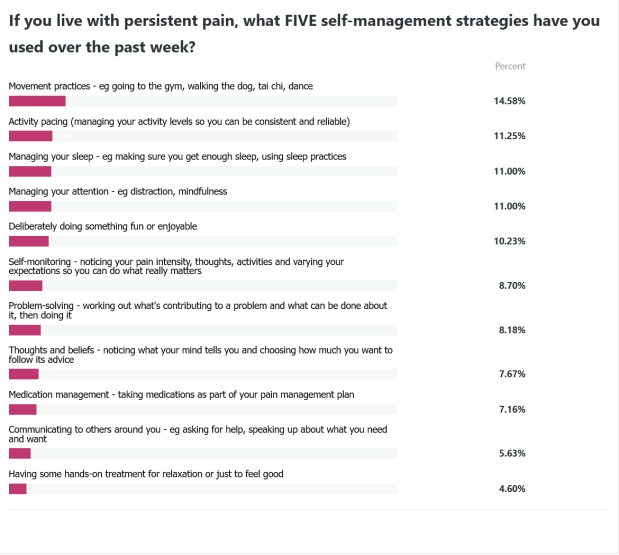The last two posts I’ve written here and here have explored differing perspectives and current debate about the term catastrophising – and I hope I’ve been clear that I don’t dispute the usefulness of (or the accumulated data about) a construct that is associated with poor outcomes across so many pain experiences. I just don’t find the term and its definition lands well with people living with pain, and the way it’s discussed amongst some clinicians is problematic. This post is my take on a nuanced approach.
The term catastrophising is defined as ‘an exaggerated negative mental set’ (Sullivan et al., 2001). Exaggerated, according to Oxford Languages dictionary, means ‘regarded or represented as larger, better, or worse than in reality.’ This means someone, somewhere needs to define ‘reality’. The argument presented by Crombez et al., (2024) is based on the complete lack of external referent for how someone should experience their pain. Pain is, as we all accept, a subjective experience. We have no external referent for how pain ought to be experienced: its intensity, qualities and meaning are individual. What we do have are inferences about ‘how bad’ pain is based on what we observe in another person, and our interpretation of what we might be like in the same situation. In other words, we use social cues, compare these with our social norms, and make a judgement.
Given we know that women, people of colour, those who don’t speak the dominant language, people who are ‘different’ and especially when there are intersections between these ‘differences’ – are likely to have pain intensity under-estimated (see this post). If the social norms we draw on are skewed, we need to ask how valid are the judgements made based on them.
Nevertheless, catastrophising has been associated with greater distress, disability and poor recovery, so what are we to do?
If we unpack the three subscales of the Pain Catastrophising Scale (Sullivan et al., 1995) they consist of (1) ‘ruminating’ or brooding on/difficulty disengaging from thoughts about pain; (2) ‘magnifiying’ or thinking the worst about pain; and (3) ‘helplessness’, or feeling there’s nothing that can help.
I’m pretty sure we’ve all had times when it’s been hard to stop brooding on a problem. Particularly in a situation of uncertainty, or where we’re trying hard to solve the problem but can’t find a way through. The ruminating subscale looks a lot like, as some authors describe it, ‘misdirected problem-solving’ (Flink et al., 2012). Doing what human brains do – setting out to solve something that maybe can’t be solved. ACT has a lot to offer in this regard with strategies for cognitive defusion, willingness and present-moment awareness.
When it comes to thinking the worst, let’s step back to see how people acquire their beliefs and feelings about pain. I ask my 5th year medical students to rate how much pain they expect to feel when asked to hold their hand in 4 degree C water for up to two minutes. I then ask them how they made that judgement given most people won’t have done it before. Their answers are revealing: they’ve seen the Wim Hof videos, they’ve jumped into a cold pool or river, some even go winter sea swimming. They’ve watched other people do it. They’ve gulped an icy cold drink and got ice-cream headache. They make inferences based on what they know, either from direct experience in similar situations, or from watching others.
Now ice water isn’t comfortable, and the students are doing this knowing that: (1) I can’t harm them because ethics; (2) it’s only for two minutes; (3) they’re in a room with all their peers but their responses are anonymous. Quite different from clinical situations where: (1) people don’t know that their pain isn’t something nasty; (2) the pain may continue for quite some time; (3) the person may be alone and their responses about pain intensity will influence treatment decisions.
People acquire their understanding about pain from media, seeing other people having similar experiences, having family members with similar experiences, looking at the interwebs, their own past experiences… They may have heard health professionals tell others (or on social media) ‘5 things making your back pain worse’ (real example, but no link – let’s not share unhelpful stuff like ‘…it is also crucial that we AVOID THE WRONG THINGS that would aggravate your pain and make it worse!). And given humans unrivaled skill to associate concepts (eg click) it’s no wonder they consider pain is terrible.
It’s not surprising people fear pain. While I don’t think we have an ‘algogenic’ society, we do have a lot of very unhelpful messaging about pain and the need to get rid of it.
Pain always holds meaning. It’s the meaning of this experience I think people are communicating when they respond to the ‘magnifying’ items on this subscale. Meaning develops from personal experience and from these external sources. Meaning doesn’t arrive fully-formed. It has a back story.
Finally, the ‘helplessness’ subscale measures the sense of being unable to do anything to help yourself. In the absence of a diagnosis (or when a diagnosis suggests only ‘experts’ can help), when the future is uncertain, when what is read about and available in the community suggests quick fixes are the thing but then they don’t work for that person, it seems reasonable to not know what to do, and feel stuck.
To summarise, we don’t have a objective measure for ‘how bad’ pain is, because it is a subjective experience with meaning to the individual experiencing it. We tend to judge another person’s demonstration of their pain in the way we think we would if we were in the same position (while retaining our privileged understanding). We live in a community where pain is routinely considered either easy to fix (with these simple steps) or incredibly difficult to fix (you’ll need surgery, hard core medications, or a life of misery). And people don’t know what to do in these situations because it’s outside of their experience (or it hasn’t gone well in the past).
I haven’t yet discussed the pejorative tones in which the term ‘catastrophising’ is used by some clinicians. This attitude is not something that can be easily ‘educated’ out of people because it arises from deeply embedded ideas of mind and body, and negative attitudes about those who experience mental ill health. These ideas are perpetuated in clinical education where nociceptors are discussed but not the ’emotional’ experience that is integral to the definition of pain. It’s furthered in medico-legal and compensation settings. Questions about ‘motivation’, ideas that clinicians can ‘detect malingering’ or ‘true effort’, notions that what’s seen in clinic represents daily life, ignorance about our own human biases … these are such complex and ingrained attitudes amongst people who hold incredible political power – and after more than 30 years consistently working to shift the dial it’s over-simplifying to suggest education is the fix.
The final point that came up for me when I read Sullivan and Tripp’s paper (2024), was the suggestion that the term should be used only by professionals with certain training, and only to other health professionals. This smacks of a certain elitism. People read their clinical reports, and they’re entitled to. The reports are often sent to other people within the health system – including insurers who may not have any clinical training whatsoever. FWIW I do agree that clinicians using the term NEED to learn about what it actually measures. Catastrophising is in the public domain, Pandora is out of the box. And as I keep harping on about: Nothing about us, without us. For person-centred care, people with pain are part of the conversation. Our voices matter and we are the people being judged. If treatments are intended to help us live well, all clinicians need to remember that we are not inert slabs of flesh. A preferable term to replace ‘catastrophising’ might be ‘pain-related distress’ or ‘pain-related worrying.’ These seem more apt than ‘exaggerated negative mental set.’ Normal people dealing with an abnormal situation. Retain the construct of difficulty disengaging from thoughts about pain; understand how helplessness comes about; and remove the term ‘exaggeration’ from the lexicon.
Crombez, G., Scott, W., & De Paepe, A. L. (2024). Knowing What We Are Talking About: The Case of Pain Catastrophizing. Journal of Pain, 25(3), 591-594. https://doi.org/10.1016/j.jpain.2023.12.014
Flink, I. K., Boersma, K., MacDonald, S., & Linton, S. J. (2012). Understanding catastrophizing from a misdirected problem-solving perspective. British Journal of Health Psychology, 17(2),
Sullivan, M. J., Bishop, S. R., & Pivik, J. (1995). The pain catastrophizing scale: Development and validation. Psychological Assessment, 7(4), 524.
Sullivan, M. J., Thorn, B., Haythornthwaite, J. A., Keefe, F., Martin, M., Bradley, L. A., & Lefebvre, J. C. (2001). Theoretical perspectives on the relation between catastrophizing and pain. Clinical Journal of Pain, 17(1), 52-64.
Sullivan, M. J. L., & Tripp, D. A. (2024). Pain Catastrophizing: Controversies, Misconceptions and Future Directions. Journal of Pain, 25(3), 575-587. https://doi.org/10.1016/j.jpain.2023.07.004










